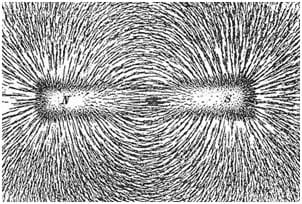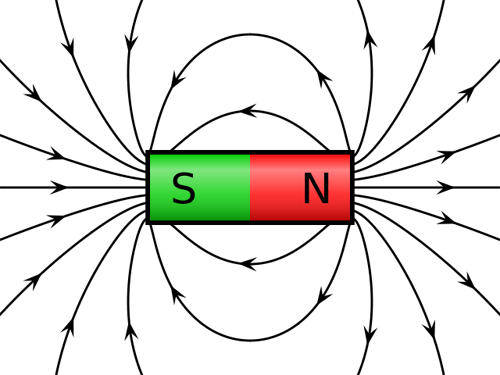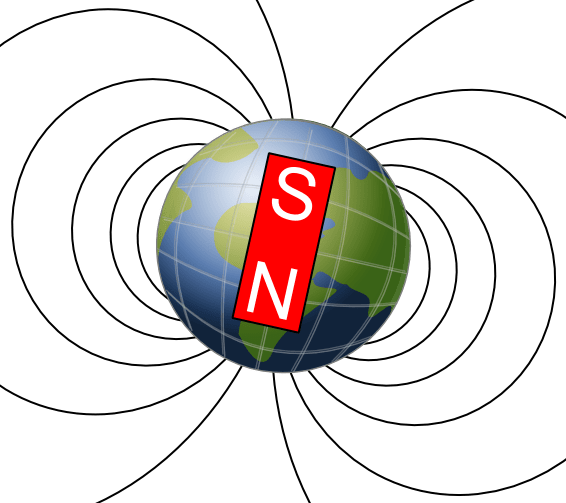Quick Look
Grade Level: 9 (8-10)
Time Required: 15 minutes
Lesson Dependency:
Subject Areas: Science and Technology

Summary
Students visualize the magnetic field of a strong permanent magnet using a compass. The lesson begins with an analogy to the effect of the Earth's magnetic field on a compass. Students see the connection that the compass simply responds to the Earth's magnetic field since it is the closest, strongest field, and thus the compass responds to the field of the permanent magnets, allowing them the ability to map the field of that magnet in the activity. This information will be important in designing a solution to the grand challenge in activity 4 of the unit.Engineering Connection
This lesson covers magnetic fields and also serves as an introduction to vector fields, which are a common theme through most electrical engineering disciplines. As discussed in the lesson closure, understanding the Earth's magnetic field is important in designing ways of protecting astronauts in space. Students will act as engineers when they use their understanding of magnets to design devices to solve the problem presented in the grand challenge later in the unit.
Learning Objectives
After this lesson, students should be able to:
- Explain the significance of the directions of magnetic field lines.
- Draw the shape of magnetic field lines around a permanent magnet.
Educational Standards
Each TeachEngineering lesson or activity is correlated to one or more K-12 science,
technology, engineering or math (STEM) educational standards.
All 100,000+ K-12 STEM standards covered in TeachEngineering are collected, maintained and packaged by the Achievement Standards Network (ASN),
a project of D2L (www.achievementstandards.org).
In the ASN, standards are hierarchically structured: first by source; e.g., by state; within source by type; e.g., science or mathematics;
within type by subtype, then by grade, etc.
Each TeachEngineering lesson or activity is correlated to one or more K-12 science, technology, engineering or math (STEM) educational standards.
All 100,000+ K-12 STEM standards covered in TeachEngineering are collected, maintained and packaged by the Achievement Standards Network (ASN), a project of D2L (www.achievementstandards.org).
In the ASN, standards are hierarchically structured: first by source; e.g., by state; within source by type; e.g., science or mathematics; within type by subtype, then by grade, etc.
International Technology and Engineering Educators Association - Technology
-
Technological problems must be researched before they can be solved.
(Grades
9 -
12)
More Details
Do you agree with this alignment?
State Standards
Tennessee - Science
-
Understand magnetic poles, magnetic fields, and investigate electromagnetic induction.
(Grades
9 -
12)
More Details
Do you agree with this alignment?
-
Sketch the magnetic field lines around a bar magnet.
(Grades
9 -
12)
More Details
Do you agree with this alignment?
Pre-Req Knowledge
An understanding of what types of materials are affected by magnetic fields and that compasses point to earth's magnetic poles
Introduction/Motivation
(Hold out a compass for the class to see.) What is this? (Respond affirmatively to the correct answer.) What does a compass do? (Expect students to know or be able to be led to the fact that a compass needle points to the magnetic north and south poles of the Earth.) The compass needle is simply a magnet.
Original compasses were made from a material called lodestones, which were first discovered in Greece, but possibly earlier in Mexico, that suspend or float in water. If you had a bunch of lodestones floating on the surface of a pond, you'd notice something interesting. All the lodestones point the same way. They called the end that pointed to the north pole "north."
What does that tell you about the Earth's north pole? (Make sure students make the connection that the Earth's geographic north pole is also its magnetic south pole.) A compass points to the Earth's north pole at most points all over the Earth. What we are doing in using a compass to navigate is mapping the Earth's magnetic field at all points on the Earth.
Now notice (hold the permanent magnet up to the compass) that other magnets also affect the compass, because the compass is responding to this magnet's magnetic field. (Position the magnet around the compass to illustrate how the needle follows the magnet.) We will use this compass to map the magnetic field of this magnet by finding its north pole and south poles. (Begin the Drawing Magnetic Fields activity.)
Lesson Background and Concepts for Teachers
Legacy Cycle Information
This lesson covers the Research and Revise part of the legacy cycle. Students are deepening their understanding of magnets by exploring the existence of a magnetic field as a description of how a magnet will attract other magnetic materials. This will ultimately be useful as the template that the electromagnet must match in order to be considered functional.
Lecture information
The magnetic field of any magnet has a looping shape that occupies three-dimensional space. The field lines loop away from the north pole and back to the south pole. Even supposedly straight lines away from north or toward south can be considered as part of an infinitely large loop. For a basic tracing of the field lines in the manner that will be conducted in the accompanying activity, see Figure 1.
The Earth also has magnetic poles that roughly align with the geographic north and south poles; however, the magnetic south pole of the Earth is near the geographic north and vice versa. The first permanent magnets, or lodestones, were found to point to these poles; the name for magnetic north of the lodestone was designated to the end of the lodestone that pointed to the geographic north, resulting in the current magnetic pole near geographic north being named south. The shape of the Earth's magnetic field largely matches that of a permanent magnet; for a visualization see Figure 2. The oldest evidence of lodestone use has been found among artifacts of the Olmec civilization in southern Mexico dating to before 1000 BC. 
Associated Activities
- Drawing Magnetic Fields - Students use a compass to map the magnetic field lines of a bar magnet. They need this information in the last activity of the unit to design a solution to the grand challenge.
Lesson Closure
(Complete this after the Drawing Magnetic Fields activity.) This is the magnetic field effect of any permanent magnet: Continuous loops begin at the north pole, point away and wrap back around to the south pole. This magnetic field protects us on Earth from radiation released from the sun during solar storms that is deflected away from the Earth by its magnetic field. An understanding of these magnetic field lines is very important for protecting astronauts in space and on the moon from specific types of radiation from solar storms.
Back to the grand challenge, magnets like these can be used to separate steel from aluminum (as seen in the previous activity), however, once we pick up the steel, these permanent magnets hold on to it until something stronger pulls it off. Over the next few activities, you will apply your knowledge of magnetic field lines to design a magnet that works better than a permanent magnet for this purpose. What would it mean for a magnet to work "better" than a permanent magnet in this engineering design challenge? (It would be better if the magnet could be turned off so the steel could be dropped.) You'll need to use your knowledge of magnetic field lines to do that.
Vocabulary/Definitions
compass: A small magnet suspended so that it can freely point to Earth's magnetic north pole.
lodestone: A naturally magnetized piece of the mineral magnetite.
Assessment
Ask students specific questions to assess understanding of material such as:
- What is the significance of the direction of magnetic fields?
- Here is a picture of a permanent magnet. Draw the field lines around it.
- Why is this important to engineers? How can engineers use this information?
Additional assessments are conducted in accompanying lessons 3 and 4.
Subscribe
Get the inside scoop on all things TeachEngineering such as new site features, curriculum updates, video releases, and more by signing up for our newsletter!More Curriculum Like This

Students investigate the properties of magnets and how engineers use magnets in technology. Specifically, students learn about magnetic memory storage, which is the reading and writing of data information using magnets, such as in computer hard drives, zip disks and flash drives.

Students are briefly introduced to Maxwell's equations and their significance to phenomena associated with electricity and magnetism. Basic concepts such as current, electricity and field lines are covered and reinforced. Through multiple topics and activities, students see how electricity and magne...

In this lesson, students are shown the very basics of navigation. The concepts of relative and absolute location, latitude, longitude and cardinal directions are discussed, as well as the use and principles of a map and compass.

Students learn how to determine location by triangulation. After the process of triangulation is described, students practice finding their locations on a worksheet, in the classroom and outdoors.
Copyright
© 2013 by Regents of the University of Colorado; original © 2011 Vanderbilt UniversityContributors
Justin Montenegro , Glencliff High School, NashvilleSupporting Program
VU Bioengineering RET Program, School of Engineering, Vanderbilt UniversityAcknowledgements
The contents of this digital library curriculum were developed under National Science Foundation RET grant nos. 0338092 and 0742871. However, these contents do not necessarily represent the policies of the NSF, and you should not assume endorsement by the federal government.
Last modified: September 8, 2021









User Comments & Tips